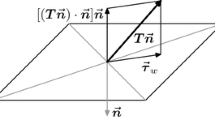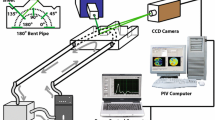Abstract
The carotid artery bifurcation is known as a site of atheromatous plaque formation which is closely related to hemodynamics. To investigate the fluid mechanics inside the bifurcation, a transparent model of the carotid geometry was built to estimate the feasibility of using stereoscopic particle image velocimetry (PIV) in a complex three-dimensional geometry. As a first approach, steady inflow conditions are considered. Velocity data are acquired in cross-sectional planes and combined to yield the full three-dimensional velocity vector field in the region of the bifurcation. The finite-time Lyapunov exponent (FTLE) is used as a criterion to reveal the complex flow structure and is found to be particularly efficient in discriminating between reverse flow and recirculation regions. The Lagrangian criterion is also computed with time-resolved, two-component PIV measurements obtained by increasing the Reynolds number up to the onset of unsteadiness. The FTLE field produces in this case a detailed visualization of the instability development.









Similar content being viewed by others
References
Adrian RJ, Christensen KT, Liu ZC (2000) Analysis and interpretation of instantaneous turbulent velocity fields. Exp Fluids 29:275–290
Bale-Glickman J, Selby K, Saloner D, Savas Ö (2003) Experimental flow studies in exact-replica phantoms of atherosclerotic carotid bifurcations under steady input conditions. J Biomech Eng 125:38–48
Berger SA, Jou LD (2000) Flows in stenotic vessels. Annu Rev Fluid Mech 32:347–384
Bharadvaj BK, Mabon RF, Giddens DP (1982a) Steady flow in a model of the human carotid bifurcation. Part I—flow visualization. J Biomech 15:349–362
Bharadvaj BK, Mabon RF, Giddens DP (1982b) Steady flow in a model of the human carotid bifurcation. Part II—laser-Doppler anemometer measurements. J Biomech 15:363–378
Botnar R, Rappitsch G, Scheidegger MB, Liepsch D, Perktold K, Boesiger P (2000) Hemodynamics in the carotid artery bifurcation: a comparison between numerical simulations and in vitro MRI measurements. J Biomech 33:137–144
Elkins CJ, Alley MT (2007) Magnetic resonance velocimetry: applications of magnetic resonance imaging in the measurement of fluid motion. Exp Fluids 43:823–858
Fischer PF, Loth F, Lee SE, Lee SW, Smith DS, Bassiouny HS (2007) Simulation of high-Reynolds number vascular flow. Comput Methods Appl Mech Eng 196:3049–3060
Haller G (2001) Distinguished material surfaces and coherent structures in three-dimensional fluid flows. Physica D 149:248–277
Hochareon P, Manning KB, Fontaine AA, Tarbell JM, Deutsch S (2004) Wall shear-rate estimation within the 50cc Penn State artificial heart using particle image velocimetry. J Biomech Eng 126:430–437
Hopkins LM, Kelly JT, Wexler AS, Prasad AK (2000) Particle image velocimetry measurements in complex geometries. Exp Fluids 29:91–95
Kähler CJ, Scholz U, Ortmanns J (2006) Wall-shear-stress and near-wall turbulence measurements up to single pixel resolution by means of long-distance micro-PIV. Exp Fluids 41:327–341
Kim HB, Hertzberg JR, Shandas R (2004) Development and validation of echo PIV. Exp Fluids 36:455–462
Ku DN (1997) Blood flow in arteries. Annu Rev Fluid Mech 29:399–434
Ku DN, Giddens DP (1987) Laser Doppler anemometer measurements of pulsatile flow in a model carotid bifurcation. J Biomech 20:407–421
Lee SW, Smith DS, Loth F, Bassiouny PFFHS (2007) Numerical and experimental simulation of transitional flow in a blood vessel junction. Num Heat Transf 51:1–22
Motomiya M, Karino T (1984) Flow patterns in the human carotid artery bifurcation. Stroke 15:50–56
Prasad AK (2000) Stereoscopic particle image velocimetry. Exp Fluids 29:103–116
Rayz VL, Berger SA, Saloner D (2007) Transitional flows in arterial fluid dynamics. Comput Methods Appl Mech Eng 196:3043–3048
Rindt CCM, van Steenhoven AA (1996) Unsteady flow in a rigid 3-D model of the carotid artery bifurcation. J Biomech Eng 118:90–96
Rindt CCM, van Steenhoven AA, Reneman RS (1988) An experimental analysis of the flow field in a three-dimensional model of the human carotid artery bifurcation. J Biomech 21:985–991
Shadden SC, Taylor CA (2008) Characterization of coherent structures in the cardiovascular system. Ann Biomed Eng 36:1152–1162
Shadden SC, Lekien F, Marsden JE (2005) Definition and properties of Lagrangian coherent structures from finite-time Lyapunov exponents in two-dimensional aperiodic flows. Physica D 212:271–304
Shadden SC, Katija K, Rosenfeld M, Marsden JE, Dabiri JO (2007) Transport and stirring induced by vortex formation. J Fluid Mech 593:315–331
Taylor CA, Draney MT (2004) Experimental and computational methods in cardiovascular fluid mechanics. Annu Rev Fluid Mech 36:197–231
Tsuei L, Savas Ö (2000) Treatment of interfaces in particle image velocimetry. Exp Fluids 29:203–214
Vennemann P, Lindken R, Westerweel J (2007) In vivo whole-field blood velocity measurement techniques. Exp Fluids 42:495–511
Yedavalli RV, Loth F, Yardimci A, Pritchard WF, Oshinski JN, Sadler L, Charbel F, Alperin N (2001) Construction of a physical model of the human carotid artery based upon in vivo magnetic resonance images. J Biomech Eng 123:372–376
Zarins CK, Giddens DP, Bharadvaj BK, Sottiurai VS, Mabon RF, Glagov S (1983) Carotid bifurcation atherosclerosis. Quantitative correlation of plaque localization with flow velocity profiles and wall shear stress. Circ Res 53:502–514
Zhao SZ, Papathanasopoulou P, Long Q, Marshall I, Xu XY (2003) Comparative study of magnetic resonance imaging and image-based computational fluid dynamics for quantification of pulsatile flow in a carotid bifurcation phantom. Ann Biomed Eng 31:962–971
Acknowledgments
The authors wish to thank M. Thiriet for the MRI data, M.-I. Farinas for the carotid model, and J.-M. Béland for technical support.
Author information
Authors and Affiliations
Corresponding author
Rights and permissions
About this article
Cite this article
Vétel, J., Garon, A. & Pelletier, D. Lagrangian coherent structures in the human carotid artery bifurcation. Exp Fluids 46, 1067–1079 (2009). https://doi.org/10.1007/s00348-009-0615-8
Received:
Revised:
Accepted:
Published:
Issue Date:
DOI: https://doi.org/10.1007/s00348-009-0615-8




